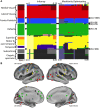The VWFA: it's not just for words anymore
- PMID: 24688462
- PMCID: PMC3960495
- DOI: 10.3389/fnhum.2014.00088
The VWFA: it's not just for words anymore
Abstract
Reading is an important but phylogenetically new skill. While neuroimaging studies have identified brain regions used in reading, it is unclear to what extent these regions become specialized for use predominantly in reading vs. other tasks. Over the past several years, our group has published three studies addressing this question, particularly focusing on whether the putative visual word form area (VWFA) is used predominantly in reading, or whether it is used more generally in a number of tasks. Our three studies utilize a range of neuroimaging techniques, including task based fMRI experiments, a seed based resting state functional connectivity (RSFC) experiment, and a network based RSFC experiment. Overall, our studies indicate that the VWFA is not used specifically or even predominantly for reading. Rather the VWFA is a general use region that has processing properties making it particularly useful for reading, though it continues to be used in any task that requires its general processing properties. Our network based RSFC analysis extends this finding to other regions typically thought to be used predominantly for reading. Here, we review these findings and describe how the three studies complement each other. Then, we argue that conceptualizing the VWFA as a brain region with specific processing characteristics rather than a brain region devoted to a specific stimulus class, allows us to better explain the activity seen in this region during a variety of tasks. Having this type of conceptualization not only provides a better understanding of the VWFA but also provides a framework for understanding other brain regions, as it affords an explanation of function that is in keeping with the long history of studying the brain in terms of the type of information processing performed (Posner, 1978).
Keywords: fMRI; occipito-temporal cortex; orthography; reading; resting-state fMRI; resting-state functional connectivity; resting-state networks; visual word form area.
Figures




Similar articles
-
Privileged Functional Connectivity between the Visual Word Form Area and the Language System.J Neurosci. 2017 May 24;37(21):5288-5297. doi: 10.1523/JNEUROSCI.0138-17.2017. Epub 2017 Apr 27. J Neurosci. 2017. PMID: 28450544 Free PMC article.
-
Structural connectivity patterns associated with the putative visual word form area and children's reading ability.Brain Res. 2014 Oct 24;1586:118-29. doi: 10.1016/j.brainres.2014.08.050. Epub 2014 Aug 22. Brain Res. 2014. PMID: 25152466 Free PMC article.
-
Relationship Between Resting State Functional Connectivity and Reading-Related Behavioural Measures in 69 Adults.Neurobiol Lang (Camb). 2024 Jun 14;5(2):589-607. doi: 10.1162/nol_a_00146. eCollection 2024. Neurobiol Lang (Camb). 2024. PMID: 38939731 Free PMC article.
-
The transition from vision to language: Distinct patterns of functional connectivity for subregions of the visual word form area.Hum Brain Mapp. 2024 Mar;45(4):e26655. doi: 10.1002/hbm.26655. Hum Brain Mapp. 2024. PMID: 38488471 Free PMC article.
-
The myth of the visual word form area.Neuroimage. 2003 Jul;19(3):473-81. doi: 10.1016/s1053-8119(03)00084-3. Neuroimage. 2003. PMID: 12880781 Review.
Cited by
-
Investigating the association between variability in sulcal pattern and academic achievement.Sci Rep. 2022 Jul 19;12(1):12323. doi: 10.1038/s41598-022-15335-y. Sci Rep. 2022. PMID: 35854034 Free PMC article.
-
Reading related white matter structures in adolescents are influenced more by dysregulation of emotion than behavior.Neuroimage Clin. 2017 Jun 23;15:732-740. doi: 10.1016/j.nicl.2017.06.020. eCollection 2017. Neuroimage Clin. 2017. PMID: 28702350 Free PMC article.
-
Neuropsychology of Learning Disabilities: The Past and the Future.J Int Neuropsychol Soc. 2017 Oct;23(9-10):930-940. doi: 10.1017/S1355617717001084. J Int Neuropsychol Soc. 2017. PMID: 29198282 Free PMC article. Review.
-
Altered Functional Connectivity of the Executive Functions Network During a Stroop Task in Children with Reading Difficulties.Brain Connect. 2018 Oct;8(8):516-525. doi: 10.1089/brain.2018.0595. Brain Connect. 2018. PMID: 30289278 Free PMC article.
-
Massive cortical reorganization in sighted Braille readers.Elife. 2016 Mar 15;5:e10762. doi: 10.7554/eLife.10762. Elife. 2016. PMID: 26976813 Free PMC article.
References
-
- Baer J., Kunter M., Sabatini J. (2009). Basic reading skills and the literacy of America's least literate adults: results from the 2003 National Assessment of Adult Literacy (NAAL) Supplemental Studies, in Statistics NCfE, (Washington, DC: ).
Publication types
Grants and funding
LinkOut - more resources
Full Text Sources
Other Literature Sources
Miscellaneous

